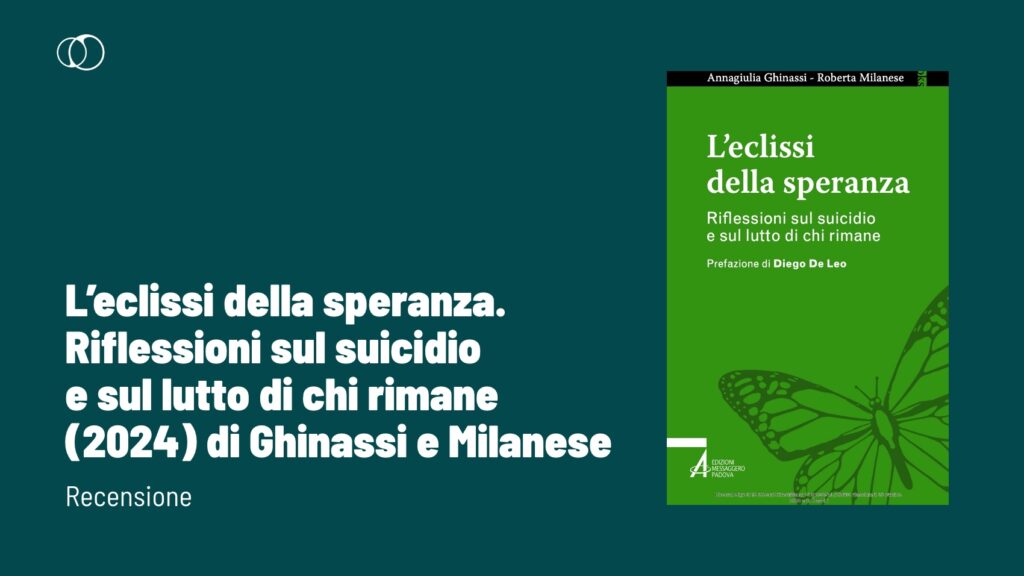
The eclipse of hope: understand the suicide and pain of those who remain
“The eclipse of hope”, a text that faces with extreme sensitivity and scientific rigor a painful and often silent theme such as that of suicide and its repercussions on who remains. The authors, Annagiulia Ghinassi Psychologist, psychotherapist and tanatologist and Roberta Milanese psychologist, psychotherapist and researcher of the Arezzo strategic therapy center, offer a lucid and profound analysis on a topic still wrapped in stigma and silences accompanying the reader with sweetness and delicacy.
During the book, not only the factors that can lead a person to take their lives are explored, but also the emotions and processes of elaboration of the mourning experienced by those who remain. Suicide is never an isolated event: it affects families, friends, colleagues, whole communities, generating questions, guilt and often a pain that is difficult to verbalizable.
The book is divided into five chapters, each of which faces a specific dimension of the suicidal phenomenon. The narration alternates scientific data, psychological reflections and really happened experiences, making the text accessible both to those who work in the field of mental health and to those who have lived this painful reality directly or indirectly.
One of the most precious elements of the book is the ability of the authors to balance the scientific approach with an empathic and human style. The preface by Diego de Leo, one of the greatest international experts on the topic, further enriches the value of the work, offering a large and documented picture on the dynamics of suicide.
Suicide is the worst of all human tragedies. Not only often constitutes the epilogue of unbearable suffering for the person who decides to implement it, but can also represent the source of an inexhaustible pain for those who are forced to survive the loss. (Cit. Diego de Leo p. 12)
Suicide: between despair and search for meaning
One of the central points of the book is the awareness that, in most cases, those who try suicide does not really want to die, but want to cease a pain that perceives as unbearable.
It is therefore important in the therapeutic work to give voice to suicidal thoughts, deepen and understand what it means to that person specifically this act, from what emotions it is governed and also be able to identify a possible leverage to work on.
Precisely because killing us is an act of freedom that nobody can take us away, why not try to live first first?(p.65)
In this sense, the authors emphasize how important it is to alleviate suffering and rekindle hope by inserting a third option between living a life that can no longer stand and commit suicide, perhaps run the risk of trying to live and perhaps risk to discover that it can also please or find its meaning.
The practical ideas compared to the techniques and therapeutic maneuvers that are reported within the book to channel or to praise the patient’s emotions are interesting.
There are also references of a social nature around the theme as the Werther effect, That is, the phenomenon according to which the news of a suicide published by the mass media causes in high society -acts in the following in the succession of the days, thePapageno effect, That is, the importance that the media spread messages capable of dissuading from suicidal thoughts, promoting stories of filming and resilience as a possible prevention of the phenomenon, the Death Education, study and research on education to the relationship to death and loss aimed at young people to unhinge the taboos, also because as the authors remember, each taboo brings with it an aura of fascination.
The role of society and its narratives are therefore analyzed around voluntary death: suicide is still a taboo, an event that many families try to hide, often declaring it as an accident to avoid social stigma. The authors highlight how this lack of collective processing can increase the sense of isolation and shame, both for those who are at suicidal risk, and for those who survive the loss of a loved one.
The mourning of who is left …
One of the most touching aspects of the book is attention to the pain of survivors. Those who lose a person for suicide often find themselves facing conflicting emotions: sadness, anger, guilt, confusion, fear of being judged. The elaboration of this type of mourning, a traumatic mourning, is complex and requires a specific path, which takes into account not only the absence of the loved one, but also of the weight of unresolved questions and relational dynamics interrupted in a traumatic way.
The authors offer precious ideas on how to support those who live this experience, underlining the importance of empathic listening and the absence of judgment. It is not a question of finding definitive answers, but of creating a space in which the pain can be welcomed and transformed.
Despite the painful theme, the book ends with a note of hope. The authors invite to reflect on how it is possible to reconstruct a sense of belonging and meaning even after experiences of deep pain. The hope, which appears in the title “eclipsed”, can return to shine through sharing, understanding and recognition of suffering as part of human experience.
“The eclipse of hope” is a necessary book, which fills a void in the debate on suicide and mourning. With a clear and engaging language, the authors manage to convey essential knowledge for anyone who wants to better understand this phenomenon, both for professional and personal experiences.
It is a text that can be useful to psychologists, psychotherapists, educators, social workers, but also to those who have lost a loved one and seek answers and tools to face pain. The great strength of the book lies in its respectful and never sensationalistic approach, which returns dignity and humanity to a theme too often reduced to mere statistical or, on the contrary, to dramatic narration without analysis.
“The eclipse of hope” is a book that speaks of pain, but also of possibilities. A text that invites you not to turn to the other side, not to keep silent, not to stop looking for ways to understand and prevent suicide. With delicacy and depth, Ghinassi and Milanese accompany us on a complex journey, but necessary, to return voice to those who have no longer been able to find it.
A book to read, to share and keep as a reference to build a more conscious and human culture on the theme of suicide and mourningo.
I like to conclude by reporting a reflection of the great psychiatrist professional and man Viktor Frankl:
Let’s try to imagine a player who, placed in front of a chess problem, does not find the solution. What does it do at that point? Overthrows the pieces of the chessboard. Is it a solution to your problem? Certainly not. But this is how the suicide reacts: he throws his life away thinking he had led a problem that appeared insoluble to him. He does not know that in this way he does not respect the rules of the game of life, just like the chess player of our comparison does not relate to the rules of his game, within which a problem is resolved with a leap in the horse, an argument or in some other way, but still with a move, certainly not with the behavior described. Now, the suicide also violates the rules of the game of life; These rules do not require us to win at all costs, but they require us not to abandon the game. (p.79)





